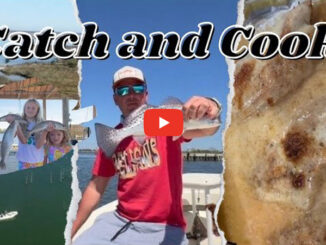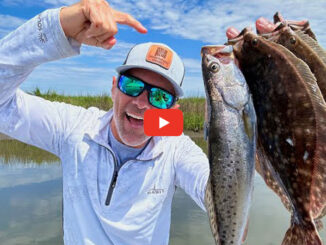
Rigs are good alternative on slack tide days in the Calcasieu Ship Channel, guide says
The original plan Tuesday morning was to head down to the Calcasieu Ship Channel with Capt. Nick Poe for a story about catching speckled trout on the ledges in deeper water during the dog days of summer.
But as dawn broke and Poe lowered the trolling motor on his 21-foot Egret Moccasin to glide over to our first stop in Cameron, he abruptly picked it up again, cranked up his Mercury 250 Pro XS and headed south — a lot further south than I anticipated going.
As we exited the Channel, Poe turned west into the Gulf of Mexico and piloted the boat through steady 1- to 3-foot rollers for the 14-mile trip to the rigs at Johnson Bayou.
“We’re either going to hit a home run today, or we’re going to strike out,” he said, shortly after confirming that I wasn’t prone to seasickness.
Turns out the bumpy trip was well worth it and Poe — with Big Lake Guide Service — definitely made the right call.
In just over an hour at our very first stop, we had 30 nice speckled trout on ice — solid 2s and 3s, with a couple pushing 4 pounds — all caught on plastics with ¼-ounce jigheads.
“I know we were planning to fish the southern part of the Calcasieu Ship Channel, and that’s where we’ve been catching all our fish,” Poe explained afterward. “But I got down there and just didn’t like what I saw.
“The tide wasn’t moving, and I expected it to be coming in harder than it was — it was just barely trickling. I decided I didn’t want to fight that today.”
The rig we fished was in about 25 feet of water, and the bite was on as soon as the plastics we used — mostly MirrOlure Lil Johns in glow, opening night and chartreuse ice and opening night H&H Baby Bull Minnows— fell into the strike zone.
“Basically, you’re giving it the same presentation as you’re giving it in the Ship Channel with your bait sweeping,” Poe said. “You need some current, but you don’t want too much because it’s a lot different out there. If there’s too much current, you can’t get a 5-pound weight to the bottom. Today, the water was a little dirty to me, but a lot of times if the water is dirty, the fish will be up in the water column and that’s what we saw.
“I caught fish 6 feet down to 8 feet down, and that’s all you can ask for. That’s easy fishing out there.”
Allowing the artificial lures to fall through the strike zone was key, and Poe would jig aggressively to accomplish just that.
“I would jig that bait way up high and let it fall, and that’s when they would hit it — when I let it fall on slack line,” he said. “That’s a big key in the Ship Channel, too, and I do that a lot.”
The goal is to keep your line slack — even though it means you won’t necessarily feel the bite.
“When fish are kind of acting like they’re getting harder to catch, give it a big high jig then let it fall on slack line,” Poe explained. “But it’s got to be on slack line, and you’re not going to feel the bite. But the next time you jig it, you’re jigging it so hard, you’re actually setting the hook.
“That’s a trick, but it works. Slack line is a big deal.”
Poe said persistent westerly winds have prevented him from fishing the Johnson Bayou rigs since June, but they can be productive if you can make it there.
When he predicted we would either hit a home run or strike out on Tuesday, he said he was worried about what the tide would be like when we arrived.
“The main thing that’s always in the back of my mind when I’m running out there is, ‘Will the tide be too hard?’ I don’t really worry about it if it’s too slow. If it’s too slow, you’re not going to catch a limit, but you’ll pull up on every one of those rigs and you’re going to catch six, and you end up at the end of the day with 40 fish so everybody is happy,” he said. “But if the tide is too strong, you’re in for it. You just got burned.
“The problem with going out there is you can look at all the tide charts in the world and it’s not going to tell you what the current in the Gulf of Mexico is doing. It’s going to tell you about the current in the Cameron jetties, or the current in the Calcasieu River, but it’s not going to tell you what it’s doing out there. So just because there’s no tide here (mid-lake), it doesn’t mean out there it’s not going to be ripping 4 knots. That’s the only thing that worries me about going — and it’s not close. It’s a one-hour boat ride, and if you go all the way out there and it’s ripping, you’re in a bind. I’ve done it plenty of times, believe me.”
But for at least the next month, Poe said he would be concentrating most of his efforts fishing over the oyster reefs on the edges of the Ship Channel — positioning his boat in 25 feet of water and casting into 10 feet and working down the ledge.
With water temperatures in the mid-80s, he said specks will be taking refuge there in deeper water until cool fronts start arriving early in the fall.
“Usually, we’ll get some kind of decent front in September, and that will set them off and they’ll start coming back up the Channel and filtering back through the lake,” he said. “We’ll start catching them under birds again out there in September, and they’ll be out on Commissary, Long Point and all the reefs.
“So it’s coming. It’s not too far. But right now, you’re pretty much Channel-bound.”




